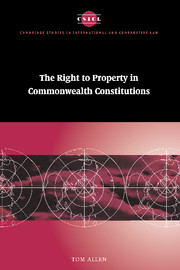Book contents
- Frontmatter
- Contents
- Table of cases
- Acknowledgements
- 1 Introduction
- 2 The right to property at common law
- 3 The development of written rights to property
- 4 Constitutional interpretation
- 5 The meaning of property
- 6 Acquisition and deprivation
- 7 Public purpose
- 8 Compensation
- Bibliography
- Index
- CAMBRIDGE STUDIES IN INTERNATIONAL AND COMPARATIVE LAW
4 - Constitutional interpretation
Published online by Cambridge University Press: 28 July 2009
- Frontmatter
- Contents
- Table of cases
- Acknowledgements
- 1 Introduction
- 2 The right to property at common law
- 3 The development of written rights to property
- 4 Constitutional interpretation
- 5 The meaning of property
- 6 Acquisition and deprivation
- 7 Public purpose
- 8 Compensation
- Bibliography
- Index
- CAMBRIDGE STUDIES IN INTERNATIONAL AND COMPARATIVE LAW
Summary
Introduction
In most Commonwealth countries, the enactment of a bill of rights brought about profound changes in the constitutional system. In many cases, the bill of rights represented a break with a colonial system characterised by political oppression and economic inequality. While the ringing endorsements of equality in bills of rights seem to support egalitarian reforms, the right to property provides the propertied classes with an instrument for resisting change. Not surprisingly, courts vary in the enthusiasm with which they approach judicial review and the right to property. The counter-majoritarian difficulty – that an unelected judiciary can invalidate legislation passed by an elected legislature – arises in respect of all fundamental rights, but it is especially acute in relation to property rights. For most judges, the resolution of the difficulty lies in the method of constitutional interpretation. Only some methods of interpretation are legitimate, but as long as a legitimate method of interpretation is followed, most judges believe that they have fulfilled their constitutional function and can therefore refute allegations that they have usurped the powers of the legislature.
This chapter therefore examines how the courts interpret the right to property. The first section of the chapter examines legalist interpretation, which concentrates on the language of the relevant provisions. The terms used to define the right to property – ‘property’, ‘acquisition’, ‘deprivation’ and ‘compensation’ – provide the courts with the structure for analysing property cases.
- Type
- Chapter
- Information
- The Right to Property in Commonwealth Constitutions , pp. 83 - 118Publisher: Cambridge University PressPrint publication year: 2000

